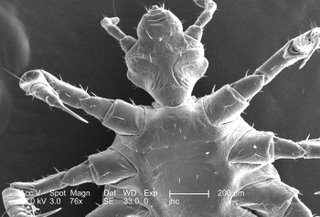
This was a scanning electron micrographic (SEM) image which focused on the head region of a female body louse, Pediculus humanus var. corporis from a ventral perspective. At a relatively low magnification, this SEM revealed some of the insect’s exoskeletal morphology exhibited by its cephalic, or head region, thoracic, and proximal abdominal regions. Of interest is the jointed configuration of its six extremities, from which it derived its classification in the phylum of Athropoda, i.e., Arthro from "joint”, and poda from "leg"). Also note the sensorial “hairs” known as “setae, which really aren’t hairs at all, but chitinous exoskeletal extensions, unlike mammalian hairs, which are made up of keratin, and make mammals unique in this regard.
What are body lice?
Body lice are parasitic insects that live on the body and in the clothing or bedding of infested humans. Infestation is common, found worldwide, and affects people of all races. Body lice infestations spread rapidly under crowded conditions where hygiene is poor and there is frequent contact among people. Infestation is unlikely to persist on anyone who bathes regularly and who regularly has access to freshly laundered clothing and bedding. Body lice are found on the body and on clothing or bedding used by infested people; lice eggs are lain in the seams of clothing or on bedding. Occasionally eggs are attached to body hair. Lice found on the hair and head are not body lice; they are head lice.
Photo Credit Janice Carr CDC 2006 Content Credits CDC/ Joseph Strycharz, Ph.D.; Kyong Sup Yoon, Ph.D.; Frank Collins, Ph.D.